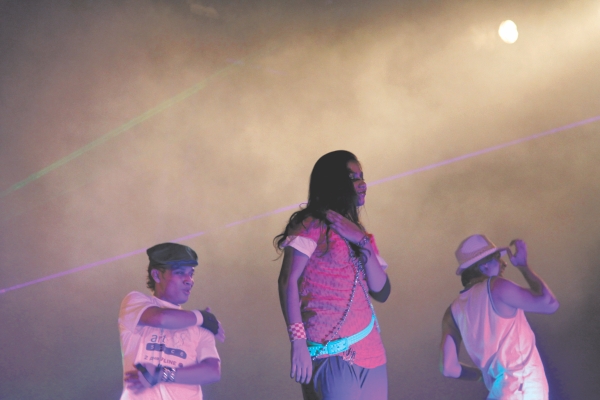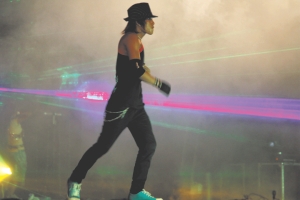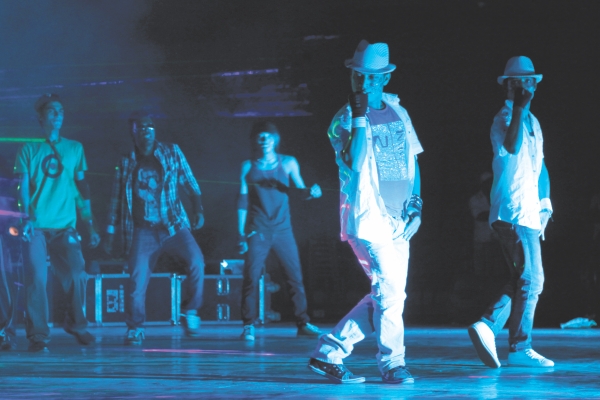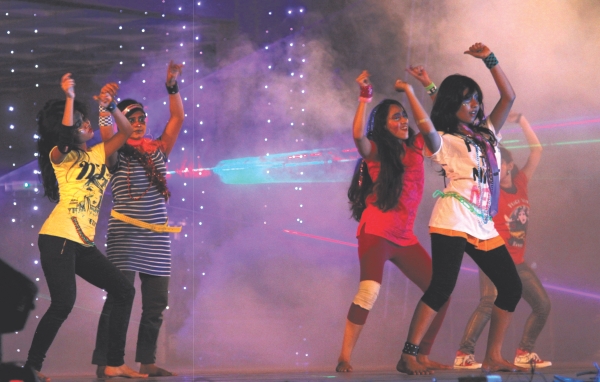| Home - Back Issues - The Team - Contact Us |
 |
| Volume 11 |Issue 28| July 13, 2012 | |
|
|
Event
The Unexpected Show Bangladesh gets a taste of hip hop dance merged with its contemporary European and classical Bengali counterparts Tamanna Khan The beautifully lit stage of Shilpakala Academy's main auditorium with blue fairy lights hanging on a background reads 'Smoke in Our Future'. Written in graffiti on a newspaper smudged wall, it promised something exciting. Yet the plastic covered stack of Mum-bottles on one side of the stage and the costume boxes on the other would make you wonder why they had not been removed; little did you know that those formed part of the stage decoration. The same thing applied to the people who walked randomly in and out of the stage while the dancers continued to dance and perform without taking notice of the intruders. Even the candy floss man and his assistant who continued to work on one side of the stage, though initially distracted the audience's attention, soon became a part of the act. The stage literally became a usual Dhaka street. One had to watch the whole performance to understand the implication of the entire informal and care-free environment.
It was exactly what Samir Akika and Andy Zondag wanted to portray – a normal Dhaka life. “I guess what we liked was to bring in the normal life on stage because for us this was our inspiration. When we are here, we see the life here. This is what gives us the inspiration to work. This is what the daily life is about and this is something very close to the people and this is what we are looking for,” Zondag tried to explain the theme, backstage after the show ended. So, we came across a hawker selling toys and children from the audience promptly went up and brought masks and rubbers balls, while some of the dancers performed and the others just loitered in the background. Sometimes, in between their performance and improvisation they took a break and indulge themselves to sweets. Even Andy, who worked as a DJ, in his black sleeveless singlet, lungi, gamcha and boots, often got up and walked like a model across the stage to the candy floss man to take a whiff of the sweet. It was hard trying to make sense of the performance while watching it, for it neither followed a format nor any sequence.
According to Akika that was exactly the whole idea behind the concept. “My obsession was that they (the participants) have fun, they feel free and they express themselves with every move possible, with the images they bring, with the music...” he explains, “I do not like to have a script because you need much more preparation to get a good script." For both Akika and Zondag the nine days they had for the workshop was not enough to pull out a show of this level. “I would need three months in Germany to reach that level,” admits Akika.
Akika and Zondag came to Dhaka to conduct a workshop organised by Alliance Française de Dhaka and Chittagong and Goethe-Institut Bangladesh as part of a Franco-German fund for cultural programme in third countries. The 'Dance in Resonance', a workshop for Bangladdeshi dancers, was selected for funding among eight other projects in Asia. For Akika and Zondag, training the participants for the show was a big challenge. On his way to Chittagong, where he was going to a second show, Akika shared how unexpected the actual situation was for him. Before coming to Bangladesh, Akika, who studied dancing and makes a living out of it, thought he would be dealing with professionals who pursue dancing as a career. Mentioning how the participants came from various backgrounds like anthropology, computer science and so on, he said, almost in a shocked tone, “I did not know that in this country there is nothing for them (career in dancing).” Though both Akika and Zondag had an idea that the dancing scenario in Bangladesh was largely occupied by traditional dance, it was from the participants that they got the real picture. “There is a huge traditional background but contemporary, modern, hip hop dance and stuff like that, it feels like that they are at the beginning here,” shared Zondag. As a result, it was difficult to get through the dancers psyche. “It was a process. They had to adjust to me. I had to adjust to them. I did not know what their reality was. So it took me a bit of time. The way I work, they are not used to it,” Akika said explaining how difficult it was to break the ice.
Nevertheless, Akika and Zondag did do a good job in breaking the rigidity of the sixteen young dancers. They also succeeded in throwing a surprise at the audience every now and then. For example, the performance started off with the touching melodies of opera and a young artiste dancing to the tune, then all of a sudden, hip hop took over; the rest of the artistes in their striking make-up and colourful attires showed up on stage. In between the hip hop moves, there were fleeting glimpses of classical dance. But what was totally unexpected was when the dancers shared bits and glimpses of their life and sometimes jokes, some of which were very inappropriate. Akika agrued, “From personal story, I try to reach big society topics if possible. My aim is to talk more about the participants not to give any kind of moral statement about how society should be.”
Given the inexperience of the dancers and the short-time they had to learn and rehearse for a show where they had to perform a dance style totally alien to their own culture, both Akika and Zondag opined that the group did an excellent job. The turnout at the Shilpakala auditorium was huge. In fact, the show started late because the number of audience exceeded the hall capacity and people where standing in the aisle hoping to enjoy the show. Reactions to the show according to Akika could have been more peaceful. “Art should be for everybody. There is not a style that is right or a style that is wrong,” Akika explained commenting on the reaction of the audience he had seen online after the show. Perhaps Akika is right. While it is good to know and appreciate one's culture, learning a new form and keeping in pace with the world should not hurt. Even though, the hip hop fusion performance might appear alien to some of us, it can motivate the young generation to experiment and learn new avenues and make themselves global citizens.
|
||||||||
|





